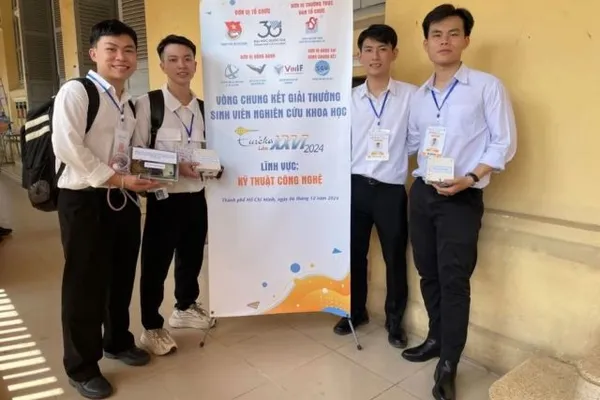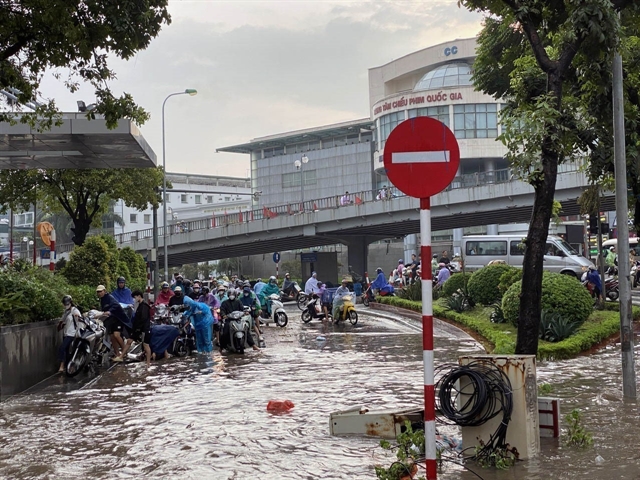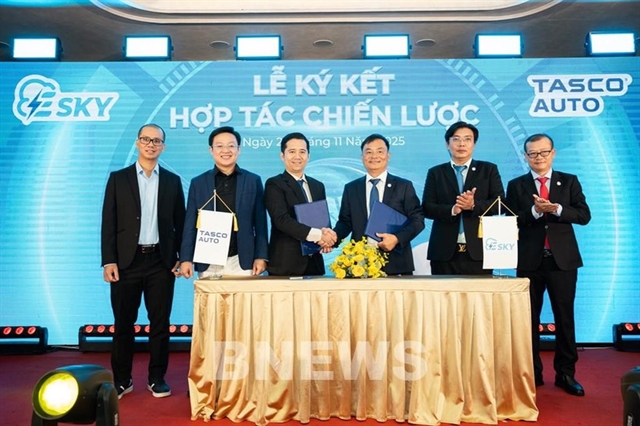 Environment
Environment

 |
| A section of Huỳnh Thúc Kháng Street in Đống Đa District, Hà Nội, is flooded during a heavy rain. — VNA/VNS Photo Vũ Sinh |
HÀ NỘI — Việt Nam could benefit from adopting Japan’s use of underground plastic rainwater storage systems to mitigate flooding. The information was shared at a seminar titled 'Underground plastic rainwater storage: a new solution for urban flood control, groundwater recharge and rainwater reuse', held on Monday in Hà Nội.
The seminar was organised by the National Centre for Water Resources Planning and Investigation under Ministry of Natural Resources and Environment in collaboration with Chichibu Chemical Co. Ltd. (Japan), the Japan International Cooperation Agency (JICA) and other partner organisations.
The workshop is part of the project 'Survey to confirm the need to use plastic rainwater retention structures to reduce flood damage in Việt Nam' proposed by Chichibu Chemical Co., Ltd. (headquartered in Chiyoda Ward, Tokyo, Japan) and selected by JICA in 2024.
This is one of the projects under the Small and Medium Enterprise Support Programme towards sustainable development goals (SDGs) to contribute to solving socio-economic problems in developing countries.
Introducing the Plastic Rainwater Storage Structure (PRSS) at the seminar, Hideyuki Muofushi from the Chichibu Chemical Co. Ltd., said that the system is primarily developed to prevent flood disasters by temporarily storing rainwater underground.
It is a system that stores rainwater in underground plastic units. The system is highly durable, with a porosity rate of over 95 per cent and is easy and quick to install.
He also said that the system can be easily assembled by hand without the need for construction machinery, as the largest component weighs only three kilogrammes.
Additionally, the design and materials of the system are unique, with the surface above ground being usable for purposes such as car parks or playgrounds.
The system is divided into two types, consisting of permeable and impermeable, offering flexibility for various uses.
Evaluating the system, Hisahito Yoshida, president of the Chichibu Chemical Co. Ltd., said that the solution has been successfully implemented in many countries worldwide, providing practical benefits such as reducing urban flooding by controlling surface runoff as well as replenishing groundwater to balance the natural ecosystem.
The system also helps in reusing rainwater for non-potable purposes such as irrigation, toilet flushing and industrial production and alleviating pressure on drainage systems and saving infrastructure investment costs.
Integrating such solutions into urban systems not only helps reduce flood risks but also contributes to the goal of more efficient, sustainable and environmentally friendly water use.
Speaking at the seminar, Triệu Đức Huy, deputy general director of the National Centre for Water Resources Planning and Investigation (NAWAPI), said that rapid urbanisation and the effects of climate change are presenting significant challenges in water resource management, particularly in densely populated cities.
Việt Nam is also facing the growing risk of urban flooding, the depletion of groundwater resources and water scarcity.
Therefore, seeking innovative, sustainable and environmentally friendly solutions is essential for optimising water usage, reusing rainwater and applying new technologies to improve water resource management.
The seminar provided an opportunity for experts, researchers, businesses and policymakers from both Việt Nam and Japan to share practical experiences, update on the latest technological advancements and discuss policy directions suitable for Việt Nam’s real-world conditions. — VNS




